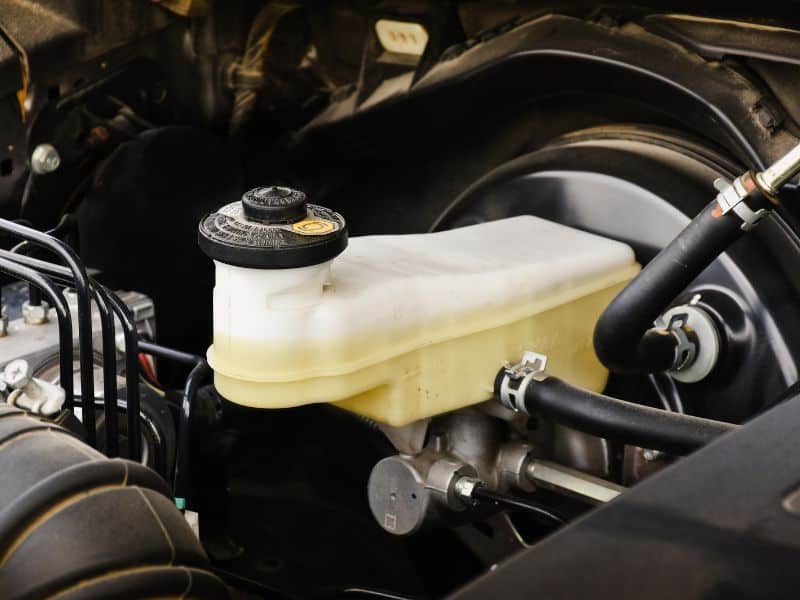When inspecting the brake fluid in your vehicle, you might wonder what color should the brake fluid be.
Brake fluid, when new, should be colorless or amber for DOT 3, DOT 4, and DOT 5.1 NON-SBBF(silicone-based brake fluid) fluids and purple for DOT 5 SBBF fluid.
In this article, I’ll explain what color brake fluid is and why it is that color, and what it does.

What does brake fluid look like?
Brake fluid should look colorless to amber for DOT 3, DOT 4, and NON-SBBF DOT 5.1 fluids when new.
It is only DOT 5 SBBF brake fluid that has a purple color because it is the only fluid that is silicone based compared to the others that are polyglycol-ether-based fluids.
If you inspect your vehicle’s brake fluid and see it is brown or blackish, it is time for a brake fluid change.
Contaminants in the brake fluid will discolor it to a brownish-black color.
If you see any other color brake fluid being sold than indicated above, it is not DOT-approved and can result in your vehicle’s brake system not functioning correctly.
You can find the complete code to the standard of vehicle brake fluids here on Title 49 Transportation Standard No. 116.
How to check brake fluid
It is always good practice to control the fluid levels of your vehicle, especially the brakes.
- You will first need to open the vehicle’s hood and find the brake reservoir; it is always located against the firewall and usually on the same side as the vehicle’s driver.
- Check the fluid level and see if it is in the indicated minimum and maximum lines on the reservoir.
- Inspect the color of the fluid; if it isn’t colorless, amber, or purple, you will need to replace the fluid. If you are unsure if the liquid is still usable, you can buy a brake fluid tester that will indicate the condition of the fluid.
Why is brake fluid important?
While a brake system is also a hydraulic system like your power steering system, it is exposed to much higher temperatures; thus, it needs a special fluid to cope with the heat and still function as it should.
If the brake fluid cannot handle high temperatures, it will start vapourising in the brake line; the vapor is highly compressible compared to a liquid, resulting in a loss of brake pressure in the system.
This is why buying DOT-approved fluids, and a suitable grade fluid for your vehicle is crucial.
What is brake fluid?
Brake fluid is a hydraulic fluid used in the automotive sector in the clutch and brake systems of motorcycles, cars, light trucks, and even some bicycles.
The brake fluid is designed to transfer force into pressure, and using different ratio master and slave cylinders in the system can amplify the force it works out on the brakes or the vehicle’s clutch.
Brake fluid looks like water but feels like oil between the fingers.
The older glycol-ether-based brake fluids are very aggressive on automotive paint and can damage it over time, while the new silicone-based DOT 5 fluids don’t affect the vehicle’s paint.
The cost of fixing the paint on the vehicle is identical to when the paint is scratched, and here is my article on how much it will cost to fix it.
Final thought on what color is brake fluid
So we have established that if the brake fluid is brown or black, it needs replacement and the Department of Transport states that all brake fluids that are non-silicone based should be colorless or amber, and silicone-based brake fluids should be purple.
Hopefully, you found this article helpful, and it will help you as a driver to correctly maintain your vehicle.
FAQs
What color is brake fluid when it needs to be changed?
If the brake fluid is brown or black, it is contaminated and will need to be changed.
Contaminated fluid will not have the same boiling point as new fluid and can result in loss of brake pressure in prolonged or emergency braking situations.
What color is DOT 3 brake fluid?
As stipulated by the Department Of Transportation, all non-silicone-based brake fluids (DOT 3, DOT 4, and DOT 5.1) should be colorless or amber.
What color is power steering fluid?
Most power steering systems use ATF (Automatic Transmission Fluid), which is red.
What happens if I mix DOT 3 and DOT 4 brake fluid?
Since DOT 3 and DOT 4 are both polyglycol-ether-based fluids, they can mix and work perfectly together.
Remember that it is now a mix of both, so that it will have a higher boiling point than DOT 3 but not as high as DOT 4.
The danger comes if you mix it into a vehicle that needs DOT 4 fluid since the fluid is now at a lower grade than recommended which can cause a loss of brake pressure under braking.
